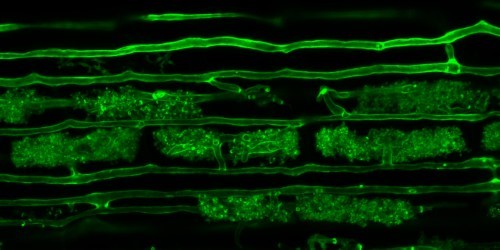Endosymbiosis for environmentally friendly farming

What is endosymbiosis?
Endosymbiosis is where two organisms are in a mutually beneficial association with one another. Plants can form these mutually beneficial associations with soil microbes, such as nitrogen-fixing bacteria called rhizobia and arbuscular mycorrhizal fungi. It is mutually beneficial because the rhizobia and arbuscular mycorrhizal fungi provide the plant with nutrients in return for photosynthetic carbon from the plant.
The environmental impact of fertiliser use is two-fold
Nitrogen and phosphate are essential nutrient for growth, and they are applied as inorganic fertiliser to crops to enhance their yield. The energy required to produce fertiliser makes up about two per cent of all the energy we use globally and nearly 1.8 per cent of global CO2 emissions. Coupled with this, over 50 per cent of applied inorganic nitrogen fertilizer is lost to the environment – it runs off into freshwater habitats such as rivers, causing pollution and impacting biodiversity.
Mutually beneficial associations between plant roots and nitrogen-fixing rhizobia or arbuscular mycorrhizal fungi enhance nutrient uptake and reduce the amount of inorganic fertiliser needed. Although biological nitrogen fixation by rhizobia occurs in root of a few orders of flowering plants, it is thought that 80 per cent of land plants can benefit from arbuscular mycorrhizal fungi and enhancing these associations will be key to making crops less dependent on inorganic fertilisers.
Our Research and Impact
The impact of endosymbiosis on plant growth is generally not observed in intensive farming conditions, as endosymbiosis occur in inorganic nutrient-poor soils. Our research has identified a mutation within a gene that enhances endosymbiosis. This mutation, originally identified in the model legume Medicago truncatula, was transferred into wheat, where it similarly enhances the association with arbuscular mycorrhizal fungi.
Arbuscular mycorrhiza and, importantly, nutrient acquisition from the soil was increased in wheat plants grown in growth chambers and in field conditions. In field trials, wheat plants carrying the gene mutation enhanced endosymbiosis with arbuscular mycorrhizal fungi by 20 per cent and showed a 10 per cent increase in leaf nitrogen to carbon ratio, an indicator of increased nutrient acquisition. Field trials in collaboration with breeders are now underway to determine whether wheat yields that are achieved with a standard fertiliser application level can be matched with the wheat lines we have generated with enhanced endosymbiosis and with less fertiliser. Furthermore, the mutation had a conserved effect between the distantly related legume and wheat, it is therefore possible that this mutation could provide enhanced endosymbiosis in other crop plants. This new knowledge provides the potential for sustainable crop production using endosymbionts alongside reduced fertiliser use.
